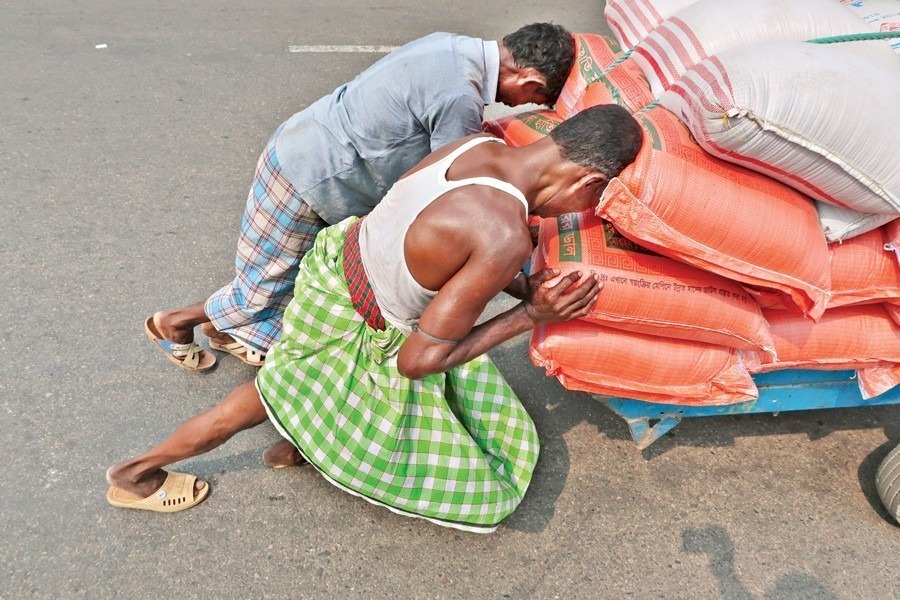
Published :
Updated :

More often than not, a T-shirt bought from countries like the United States of America (USA) and Australia will have a tag saying, "Made in Bangladesh", reflecting the position Bangladesh's RMG sector holds in the international market. The RMG sector contributes to 81 per cent of the country's export earnings, making it an essential benefactor to Bangladesh's economy. However, when it comes to international trade, it is important not only to establish yourself but also to ensure that you maintain that position.
The sector grew upon the back of cheap labour; however, is that truly enough? Competitors such as India, China and Vietnam are only evolving with each passing day, making it essential for Bangladesh to find an edge over the others. With increasing alarm about climate change and initiatives such as the UN Fashion Industry Charter for Climate Action, international markets are shifting toward sustainable and climate-friendly supply chains. This serves Bangladesh as a golden opportunity. Why then has little effort been made to adopt renewable energy technology (RET) - what are the key drivers, barriers, and prospects shaping this transition?
Even though the adoption of RET has been slow, there are multiple encouraging motivating factors.
For global buyers, sustainability is now an essential criterion. Major international brands are now setting emission reduction targets across their supply chains. This puts factories under immense pressure to adopt cleaner energy sources. Factories that invest in RETs are more likely to retain contracts, attract new buyers, and meet the sustainability certifications increasingly required in global markets. As a professor of the Electrical and Electronic Engineering (EEE) department of the country's leading engineering school, BUET, observed, "A product becomes more acceptable in the international market when a buyer knows that even 20 per cent of its energy comes from green sources".
Considering that profit ultimately drives decision-making in the industry, the long-term financial returns of renewable energy are among the most compelling incentives. While the initial installation cost of rooftop solar can be significant, the return on investment becomes evident over time. Once installed, solar panels generate electricity at a minimal recurring cost, reducing factories' dependency on expensive and volatile fossil fuel-based power. "If you install a solar power plant, the cost will be recouped within 4-5 years because the electricity price has risen and it will rise more," explained an energy specialist working in the World Bank Group. He also noted that the government is already receiving a 9.5-cent bid for solar IPP (Independent Power Producer), which is competitive with-or even cheaper than-grid electricity, typically costing 10-11 cents per unit. Under Bangladesh's updated net metering guidelines (2019), factories can also supply excess electricity back to the grid at approximately Tk 6 per unit, further offsetting energy costs and strengthening the economic case for renewable adoption.
While the incentives are strong, the adoption of renewable energy in the RMG sector continues to face a host of interconnected barriers.
The return on investment from renewable sources is typically visible within five years. However, that initial investment can be prohibitively high-up to US$ 100-120 million for a 100 MW plant. Therefore, high-interest loans are often necessary to take out. A leading energy analyst noted that while ROI may be positive in the long term, loans typically require repayment within five years. Since business decisions are still dominated by short-term profit, many factory owners are reluctant to invest in RETs.
Government policy further exacerbates this hesitancy. Even though the Renewable Energy Policy 2008 was updated in 2025 and the net metering guidelines were revised, there is still no comprehensive framework addressing the unique constraints of the RMG sector.
Several energy analysts have expressed the need for off-site generation models or corporate power purchase agreements (CPPAs) to ensure that factories that do not have adequate infrastructure for rooftop solar are not sidelined.
Despite the challenges, the future of renewable energy in Bangladesh's RMG sector shows promise.
Organisations such as BGMEA are actively working to hold training programs to raise awareness regarding financial scopes like refinancing while also disseminating information about the benefits of RET adoption as a means of encouraging industry leaders. Moreover, lowering import duties on solar equipment holds enormous potential as it could significantly reduce capital costs and encourage RET adoption, especially for smaller factories. Finally, a policy framework for off-site renewable power-via CPPAs-could improve energy access. An energy specialist at the World Bank emphasised that such models would allow factories to source energy from remote solar plants through the national grid.
According to the World Trade Organization (WTO), Vietnam, the world's third-largest exporter of textiles after Bangladesh, showed significantly higher exports in 2024 than in 2023, whereas Bangladesh had only a marginal increase. In response, Bangladesh must take decisive action. To ensure that the "Made in Bangladesh" tag retains its place in the hands of the world, cleaner energy must be embraced.
naziah.anika.ahmed@g.bracu.ac.bd


 For all latest news, follow The Financial Express Google News channel.
For all latest news, follow The Financial Express Google News channel.